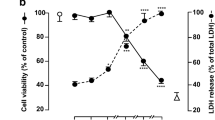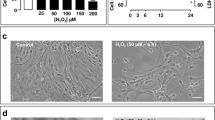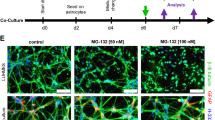Abstract
Astrocytes play pivotal roles in regulating glutamate homeostasis at tripartite synapses. Inhibition of soluble epoxide hydrolase (sEHi) provides neuroprotection by blocking the degradation of 14,15-epoxyeicosatrienoic acid (14,15-EET), a lipid mediator whose synthesis can be activated downstream from group 1 metabotropic glutamate receptor (mGluR) signaling in astrocytes. However, it is unclear how sEHi regulates glutamate excitotoxicity. Here, we used three primary rat cortical culture systems, neuron-enriched (NE), astrocyte-enriched glia-neuron mix (GN), and purified astrocytes, to delineate the underlying mechanism by which sEHi and 14,15-EET attenuate excitotoxicity. We found that sEH inhibitor 12-(3-adamantan-1-yl-ureido)-dodecanoic acid (AUDA) and 14,15-EET both attenuated N-methyl-D-aspartate (NMDA)-induced neurite damage and cell death in GN, not NE, cortical cultures. The anti-excitotoxic effects of 14,15-EET and AUDA were both blocked by the group 1 mGluR5 antagonist 2-methyl-6-(phenylethynyl)pyridine (MPEP), as were their protective effects against NMDA-disrupted perineuronal astrocyte processes expressing glutamate transporter-1 (GLT-1) and subsequent glutamate uptake. Knockdown of sEH expression also attenuated NMDA neurotoxicity in mGluR5- and GLT-1-dependent manners. The 14,15-EET/AUDA-preserved astroglial integrity was confirmed in glutamate-stimulated primary astrocytes along with the reduction of the c-Jun N-terminal kinase 1 phosphorylation, in which the 14,15-EET effect is mGluR5-dependent. In vivo studies validated that sEHi and genetic deletion of sEH (Ephx2-KO) ameliorated excitotoxic kainic acid-induced seizure, memory impairment, and neuronal loss while preserving GLT-1-expressing perineuronal astrocytes in hippocampal CA3 subregions. These results suggest that 14,15-EET mediates mGluR5-dependent anti-excitotoxicity by protecting astrocytes to maintain glutamate homeostasis, which may account for the beneficial effect of sEH inhibition in excitotoxic brain injury and diseases.








Similar content being viewed by others
Change history
18 July 2019
The original version of this article unfortunately contained a mistake. The authors observed inadvertent error in Fig. 7d, in which the image of the GFAP/DAPI in the WT saline treated mice was rotated left 90-degree by mistake. The corrected representative image is given below.
References
Sattler R, Tymianski M (2001) Molecular mechanisms of glutamate receptor-mediated excitotoxic neuronal cell death. Mol Neurobiol 24:107–129. https://doi.org/10.1385/MN:24:1-3:107
Hardingham GE, Bading H (2010) Synaptic versus extrasynaptic NMDA receptor signalling: implications for neurodegenerative disorders. Nat Rev Neurosci 11:682-696. https://doi.org/10.1038/nrn2911
Grewer C, Gameiro A, Zhang Z, Tao Z, Braams S, Rauen T (2008) Glutamate forward and reverse transport: from molecular mechanism to transporter-mediated release after ischemia. IUBMB Life 60:609–619. https://doi.org/10.1002/iub.98
Mark LP, Prost RW, Ulmer JL, Smith MM, Daniels DL, Strottmann JM, Brown WD, Hacein-Bey L (2001) Pictorial review of glutamate excitotoxicity: fundamental concepts for neuroimaging. AJNR Am J Neuroradiol 22:1813–1824
Rose CR, Felix L, Zeug A, Dietrich D, Reiner A, Henneberger C (2017) Astroglial glutamate signaling and uptake in the hippocampus. Front Mol Neurosci 10:451. https://doi.org/10.3389/fnmol.2017.00451
Hoshi A, Tsunoda A, Yamamoto T, Tada M, Kakita A, Ugawa Y (2018) Altered expression of glutamate transporter-1 and water channel protein aquaporin-4 in human temporal cortex with Alzheimer’s disease. Neuropathol Appl Neurobiol 44:628–638. https://doi.org/10.1111/nan.12475
Rossi D, Brambilla L, Valori CF, Roncoroni C, Crugnola A, Yokota T, Bredesen DE, Volterra A (2008) Focal degeneration of astrocytes in amyotrophic lateral sclerosis. Cell Death Differ 15:1691–1700. https://doi.org/10.1038/cdd.2008.99
Hernandez-Jimenez M, Martinez-Lopez D, Gabande-Rodriguez E, Martin-Segura A, Lizasoain I, Ledesma MD, Dotti CG, Moro MA (2016) Seladin-1/DHCR24 is neuroprotective by associating EAAT2 glutamate transporter to lipid rafts in experimental stroke. Stroke 47:206–213. https://doi.org/10.1161/STROKEAHA.115.010810
Takahashi K, Foster JB, Lin CL (2015) Glutamate transporter EAAT2: regulation, function, and potential as a therapeutic target for neurological and psychiatric disease. Cell Mol Life Sci 72:3489–3506. https://doi.org/10.1007/s00018-015-1937-8
Panatier A, Robitaille R (2016) Astrocytic mGluR5 and the tripartite synapse. Neuroscience 323:29–34. https://doi.org/10.1016/j.neuroscience.2015.03.063
Lavialle M, Aumann G, Anlauf E, Prols F, Arpin M, Derouiche A (2011) Structural plasticity of perisynaptic astrocyte processes involves ezrin and metabotropic glutamate receptors. Proc Natl Acad Sci U S A 108:12915–12919. https://doi.org/10.1073/pnas.1100957108
Bruno V, Battaglia G, Copani A, Cespedes VM, Galindo MF, Cena V, Sanchez-Prieto J, Gasparini F et al (2001) An activity-dependent switch from facilitation to inhibition in the control of excitotoxicity by group I metabotropic glutamate receptors. Eur J Neurosci 13:1469–1478
Vermeiren C, Najimi M, Vanhoutte N, Tilleux S, de Hemptinne I, Maloteaux JM, Hermans E (2005) Acute up-regulation of glutamate uptake mediated by mGluR5a in reactive astrocytes. J Neurochem 94:405–416. https://doi.org/10.1111/j.1471-4159.2005.03216.x
Takuma K, Baba A, Matsuda T (2004) Astrocyte apoptosis: implications for neuroprotection. Prog Neurobiol 72:111–127. https://doi.org/10.1016/j.pneurobio.2004.02.001
Wang JQ, Fibuch EE, Mao L (2007) Regulation of mitogen-activated protein kinases by glutamate receptors. J Neurochem 100:1–11. https://doi.org/10.1111/j.1471-4159.2006.04208.x
Ulas J, Satou T, Ivins KJ, Kesslak JP, Cotman CW, Balazs R (2000) Expression of metabotropic glutamate receptor 5 is increased in astrocytes after kainate-induced epileptic seizures. Glia 30:352–361
Geurts JJ, Wolswijk G, Bo L, van der Valk P, Polman CH, Troost D, Aronica E (2003) Altered expression patterns of group I and II metabotropic glutamate receptors in multiple sclerosis. Brain 126:1755–1766. https://doi.org/10.1093/brain/awg179
Iliff JJ, Jia J, Nelson J, Goyagi T, Klaus J, Alkayed NJ (2010) Epoxyeicosanoid signaling in CNS function and disease. Prostaglandins Other Lipid Mediat 91:68–84. https://doi.org/10.1016/j.prostaglandins.2009.06.004
Davis CM, Liu X, Alkayed NJ (2017) Cytochrome P450 eicosanoids in cerebrovascular function and disease. Pharmacol Ther 179:31–46. https://doi.org/10.1016/j.pharmthera.2017.05.004
Chang LH, Lin HC, Huang SS, Chen IC, Chu KW, Chih CL, Liang YW, Lee YC et al (2018) Blockade of soluble epoxide hydrolase attenuates post-ischemic neuronal hyperexcitation and confers resilience against stroke with TrkB activation. Sci Rep 8:118. https://doi.org/10.1038/s41598-017-18558-6
Zhang W, Otsuka T, Sugo N, Ardeshiri A, Alhadid YK, Iliff JJ, DeBarber AE, Koop DR et al (2008) Soluble epoxide hydrolase gene deletion is protective against experimental cerebral ischemia. Stroke 39:2073–2078. https://doi.org/10.1161/STROKEAHA.107.508325
Liu M, Zhu Q, Wu J, Yu X, Hu M, Xie X, Yang Z, Yang J et al (2017) Glutamate affects the production of epoxyeicosanoids within the brain: The up-regulation of brain CYP2J through the MAPK-CREB signaling pathway. Toxicology 381:31–38. https://doi.org/10.1016/j.tox.2017.02.008
Morisseau C, Inceoglu B, Schmelzer K, Tsai HJ, Jinks SL, Hegedus CM, Hammock BD (2010) Naturally occurring monoepoxides of eicosapentaenoic acid and docosahexaenoic acid are bioactive antihyperalgesic lipids. J Lipid Res 51:3481–3490. https://doi.org/10.1194/jlr.M006007
Wu HF, Chen YJ, Wu SZ, Lee CW, Chen IT, Lee YC, Huang CC, Hsing CH et al (2017) Soluble epoxide hydrolase inhibitor and 14,15-epoxyeicosatrienoic acid-facilitated long-term potentiation through cAMP and CaMKII in the hippocampus. Neural Plast 2017:3467805. https://doi.org/10.1155/2017/3467805
Sellers KW, Sun C, Diez-Freire C, Waki H, Morisseau C, Falck JR, Hammock BD, Paton JF et al (2005) Novel mechanism of brain soluble epoxide hydrolase-mediated blood pressure regulation in the spontaneously hypertensive rat. FASEB J 19:626–628. https://doi.org/10.1096/fj.04-3128fje
Lin CH, Juan SH, Wang CY, Sun YY, Chou CM, Chang SF, Hu SY, Lee WS et al (2008) Neuronal activity enhances aryl hydrocarbon receptor-mediated gene expression and dioxin neurotoxicity in cortical neurons. J Neurochem 104:1415–1429. https://doi.org/10.1111/j.1471-4159.2007.05098.x
Hung CC, Lin CH, Chang H, Wang CY, Lin SH, Hsu PC, Sun YY, Lin TN et al (2016) Astrocytic GAP43 induced by the TLR4/NF-kappaB/STAT3 axis attenuates astrogliosis-mediated microglial activation and neurotoxicity. J Neurosci 36:2027–2043. https://doi.org/10.1523/JNEUROSCI.3457-15.2016
Wu PC, Kao LS (2016) Calcium regulation in mouse mesencephalic neurons-differential roles of Na(+)/Ca(2+) exchanger, mitochondria and endoplasmic reticulum. Cell Calcium 59:299–311. https://doi.org/10.1016/j.ceca.2016.03.008
Xie C, Sun J, Qiao W, Lu D, Wei L, Na M, Song Y, Hou X et al (2011) Administration of simvastatin after kainic acid-induced status epilepticus restrains chronic temporal lobe epilepsy. PLoS One 6:e24966. https://doi.org/10.1371/journal.pone.0024966
Ben-Ari Y, Cossart R (2000) Kainate, a double agent that generates seizures: two decades of progress. Trends Neurosci 23:580–587
Avignone E, Ulmann L, Levavasseur F, Rassendren F, Audinat E (2008) Status epilepticus induces a particular microglial activation state characterized by enhanced purinergic signaling. J Neurosci 28:9133–9144. https://doi.org/10.1523/JNEUROSCI.1820-08.2008
Antunes M, Biala G (2012) The novel object recognition memory: neurobiology, test procedure, and its modifications. Cogn Process 13:93–110. https://doi.org/10.1007/s10339-011-0430-z
Iliff JJ, Alkayed NJ (2009) Soluble epoxide hydrolase inhibition: targeting multiple mechanisms of ischemic brain injury with a single agent. Future Neurol 4:179–199
Hardingham GE, Fukunaga Y, Bading H (2002) Extrasynaptic NMDARs oppose synaptic NMDARs by triggering CREB shut-off and cell death pathways. Nat Neurosci 5:405–414. https://doi.org/10.1038/nn835
Gauthier KM, Deeter C, Krishna UM, Reddy YK, Bondlela M, Falck JR, Campbell WB (2002) 14,15-Epoxyeicosa-5(Z)-enoic acid: a selective epoxyeicosatrienoic acid antagonist that inhibits endothelium-dependent hyperpolarization and relaxation in coronary arteries. Circ Res 90:1028–1036
Yuan L, Liu J, Dong R, Zhu J, Tao C, Zheng R, Zhu S (2015) 14,15-Epoxyeicosatrienoic acid promotes production of BDNF from astrocytes and exerts neuroprotective effects during ischemic injury. Neuropathol Appl Neurobiol 42:607–620. https://doi.org/10.1111/nan.12291
Ibanez I, Diez-Guerra FJ, Gimenez C, Zafra F (2016) Activity dependent internalization of the glutamate transporter GLT-1 mediated by beta-arrestin 1 and ubiquitination. Neuropharmacology 107:376–386. https://doi.org/10.1016/j.neuropharm.2016.03.042
Trabelsi Y, Amri M, Becq H, Molinari F, Aniksztejn L (2017) The conversion of glutamate by glutamine synthase in neocortical astrocytes from juvenile rat is important to limit glutamate spillover and peri/extrasynaptic activation of NMDA receptors. Glia 65:401–415. https://doi.org/10.1002/glia.23099
Umpierre AD, West PJ, White JA, Wilcox KS (2018) Conditional knockout of mGluR5 from astrocytes during epilepsy development impairs high-frequency glutamate uptake. J Neurosci 39:727–742. https://doi.org/10.1523/jneurosci.1148-18.2018
Zhou J, Sutherland ML (2004) Glutamate transporter cluster formation in astrocytic processes regulates glutamate uptake activity. J Neurosci 24:6301–6306. https://doi.org/10.1523/JNEUROSCI.1404-04.2004
Evstratova A, Toth K (2014) Information processing and synaptic plasticity at hippocampal mossy fiber terminals. Front Cell Neurosci 8:28. https://doi.org/10.3389/fncel.2014.00028
Rolls ET (2013) The mechanisms for pattern completion and pattern separation in the hippocampus. Front Syst Neurosci 7:74. https://doi.org/10.3389/fnsys.2013.00074
Hung YW, Hung SW, Wu YC, Wong LK, Lai MT, Shih YH, Lee TS, Lin YY (2015) Soluble epoxide hydrolase activity regulates inflammatory responses and seizure generation in two mouse models of temporal lobe epilepsy. Brain Behav Immun 43:118–129. https://doi.org/10.1016/j.bbi.2014.07.016
Terashvili M, Sarkar P, Nostrand MV, Falck JR, Harder DR (2012) The protective effect of astrocyte-derived 14,15-epoxyeicosatrienoic acid on hydrogen peroxide-induced cell injury in astrocyte-dopaminergic neuronal cell line co-culture. Neuroscience 223:68–76. https://doi.org/10.1016/j.neuroscience.2012.07.045
D’Ascenzo M, Fellin T, Terunuma M, Revilla-Sanchez R, Meaney DF, Auberson YP, Moss SJ, Haydon PG (2007) mGluR5 stimulates gliotransmission in the nucleus accumbens. Proc Natl Acad Sci U S A 104:1995–2000. https://doi.org/10.1073/pnas.0609408104
Dhanasekaran DN, Reddy EP (2008) JNK signaling in apoptosis. Oncogene 27:6245–6251. https://doi.org/10.1038/onc.2008.301
Ben Haim L, Carrillo-de Sauvage MA, Ceyzeriat K, Escartin C (2015) Elusive roles for reactive astrocytes in neurodegenerative diseases. Front Cell Neurosci 9:278. https://doi.org/10.3389/fncel.2015.00278
Sanna MD, Ghelardini C, Galeotti N (2015) Activation of JNK pathway in spinal astrocytes contributes to acute ultra-low-dose morphine thermal hyperalgesia. Pain 156:1265–1275. https://doi.org/10.1097/j.pain.0000000000000164
de Lemos L, Junyent F, Camins A, Castro-Torres RD, Folch J, Olloquequi J, Beas-Zarate C, Verdaguer E et al (2018) Neuroprotective effects of the absence of JNK1 or JNK3 isoforms on kainic acid-induced temporal lobe epilepsy-like symptoms. Mol Neurobiol 55:4437–4452. https://doi.org/10.1007/s12035-017-0669-1
Auladell C, de Lemos L, Verdaguer E, Ettcheto M, Busquets O, Lazarowski A, Beas-Zarate C, Olloquequi J et al (2017) Role of JNK isoforms in the kainic acid experimental model of epilepsy and neurodegeneration. Front Biosci (Landmark Ed) 22:795–814
Spigolon G, Veronesi C, Bonny C, Vercelli A (2010) c-Jun N-terminal kinase signaling pathway in excitotoxic cell death following kainic acid-induced status epilepticus. Eur J Neurosci 31:1261–1272. https://doi.org/10.1111/j.1460-9568.2010.07158.x
Qu Y, Liu Y, Zhu Y, Chen L, Sun W, Zhu Y (2017) Epoxyeicosatrienoic acid inhibits the apoptosis of cerebral microvascular smooth muscle cells by oxygen glucose deprivation via targeting the JNK/c-Jun and mTOR signaling pathways. Mol Cell 40:837–846. https://doi.org/10.14348/molcells.2017.0084
Ma J, Zhang L, Han W, Shen T, Ma C, Liu Y, Nie X, Liu M et al (2012) Activation of JNK/c-Jun is required for the proliferation, survival, and angiogenesis induced by EET in pulmonary artery endothelial cells. J Lipid Res 53:1093–1105. https://doi.org/10.1194/jlr.M024398
Malherbe P, Kratochwil N, Zenner MT, Piussi J, Diener C, Kratzeisen C, Fischer C, Porter RH (2003) Mutational analysis and molecular modeling of the binding pocket of the metabotropic glutamate 5 receptor negative modulator 2-methyl-6-(phenylethynyl)-pyridine. Mol Pharmacol 64:823–832. https://doi.org/10.1124/mol.64.4.823
Doria JG, Silva FR, de Souza JM, Vieira LB, Carvalho TG, Reis HJ, Pereira GS, Dobransky T et al (2013) Metabotropic glutamate receptor 5 positive allosteric modulators are neuroprotective in a mouse model of Huntington’s disease. Br J Pharmacol 169:909–921. https://doi.org/10.1111/bph.12164
Spector AA, Norris AW (2007) Action of epoxyeicosatrienoic acids on cellular function. Am J Phys Cell Phys 292:C996–C1012. https://doi.org/10.1152/ajpcell.00402.2006
Park SK, Herrnreiter A, Pfister SL, Gauthier KM, Falck BA, Falck JR, Campbell WB (2018) GPR40 is a low-affinity epoxyeicosatrienoic acid receptor in vascular cells. J Biol Chem 293:10675–10691. https://doi.org/10.1074/jbc.RA117.001297
Ma D, Tao B, Warashina S, Kotani S, Lu L, Kaplamadzhiev DB, Mori Y, Tonchev AB et al (2007) Expression of free fatty acid receptor GPR40 in the central nervous system of adult monkeys. Neurosci Res 58:394–401. https://doi.org/10.1016/j.neures.2007.05.001
Yang Y, Tian X, Xu D, Zheng F, Lu X, Zhang Y, Ma Y, Li Y et al (2018) GPR40 modulates epileptic seizure and NMDA receptor function. Sci Adv 4:eaau2357. https://doi.org/10.1126/sciadv.aau2357
Sakers K, Lake AM, Khazanchi R, Ouwenga R, Vasek MJ, Dani A, Dougherty JD (2017) Astrocytes locally translate transcripts in their peripheral processes. Proc Natl Acad Sci U S A 114:E3830–E3838. https://doi.org/10.1073/pnas.1617782114
Perez-Alvarez A, Navarrete M, Covelo A, Martin ED, Araque A (2014) Structural and functional plasticity of astrocyte processes and dendritic spine interactions. J Neurosci 34:12738–12744. https://doi.org/10.1523/JNEUROSCI.2401-14.2014
Bernardinelli Y, Muller D, Nikonenko I (2014) Astrocyte-synapse structural plasticity. Neural Plast 2014:232105. https://doi.org/10.1155/2014/232105
Koehler RC, Roman RJ, Harder DR (2009) Astrocytes and the regulation of cerebral blood flow. Trends Neurosci 32:160–169. https://doi.org/10.1016/j.tins.2008.11.005
MacVicar BA, Newman EA (2015) Astrocyte regulation of blood flow in the brain. Cold Spring Harb Perspect Biol 7:a020388. https://doi.org/10.1101/cshperspect.a020388
Dal-Cim T, Martins WC, Santos AR, Tasca CI (2011) Guanosine is neuroprotective against oxygen/glucose deprivation in hippocampal slices via large conductance Ca(2)+-activated K+ channels, phosphatidilinositol-3 kinase/protein kinase B pathway activation and glutamate uptake. Neuroscience 183:212–220. https://doi.org/10.1016/j.neuroscience.2011.03.022
Inceoglu B, Zolkowska D, Yoo HJ, Wagner KM, Yang J, Hackett E, Hwang SH, Lee KS et al (2013) Epoxy fatty acids and inhibition of the soluble epoxide hydrolase selectively modulate GABA mediated neurotransmission to delay onset of seizures. PLoS One 8:e80922. https://doi.org/10.1371/journal.pone.0080922
Liddelow SA, Barres BA (2017) Reactive astrocytes: production, function, and therapeutic potential. Immunity 46:957–967. https://doi.org/10.1016/j.immuni.2017.06.006
Kobayashi E, Nakano M, Kubota K, Himuro N, Mizoguchi S, Chikenji T, Otani M, Mizue Y et al (2018) Activated forms of astrocytes with higher GLT-1 expression are associated with cognitive normal subjects with Alzheimer pathology in human brain. Sci Rep 8:1712. https://doi.org/10.1038/s41598-018-19442-7
Acknowledgments
We thank Drs. Anya Maan-Yuh Lin, I-Hui Lee, Hui-Ching Lin, Pei-Chun Wu, and Yeh-Shiu Chu for critical comments and suggestions; Prof. Ming-Yen Cheng at Department of Mathematics, Hong Kong Baptist University for verifying the statistical analysis; Su-Pei Hsu and Wan-Ci Chen for technical assistance; and the technical services provided by Imaging Core Facility of Nanotechnology of the UST-YMU, Taiwan.
Funding
This work was supported by grants from the Anesthesiology Research and Development Foundation (ARDF10503), the Ministry of Science and Technology (MOST103-2321-B-010-011, 105-2320-B-400-001), and the Brain Research Center, National Yang-Ming University (107BRC-B405, 108BRC-B404) from the Featured Areas Research Center Program within the framework of the Higher Education Sprout Project by the Ministry of Education in Taiwan.
Author information
Authors and Affiliations
Contributions
YMK, PCH, CCH, YYH, CHL, YJH, and YHL performed the experiments and analyzed the data; YMK, PCH, CCH, YYH, LSK, and YHL designed the experiments; YMK and YHL wrote the manuscript; FSS, WKC, MYT, and LSK commented on and proofread the manuscript.
Corresponding author
Ethics declarations
Ethical Approval
All the procedures with animals were approved by the Experimental Animal Review Committee at National Yang-Ming University (Taipei, Taiwan). IACUC no.: 1060108. Animal care was performed in compliance and according to the guidelines of IACUC and the Guide for the Care and Use of Laboratory Animals of the National Institute of Health (USA) regarding the care and use of animals for experimental procedures.
Conflict of Interest
The authors declare that they have no conflict of interest.
Additional information
Publisher’s Note
Springer Nature remains neutral with regard to jurisdictional claims in published maps and institutional affiliations.
Rights and permissions
About this article
Cite this article
Kuo, YM., Hsu, PC., Hung, CC. et al. Soluble Epoxide Hydrolase Inhibition Attenuates Excitotoxicity Involving 14,15-Epoxyeicosatrienoic Acid–Mediated Astrocytic Survival and Plasticity to Preserve Glutamate Homeostasis. Mol Neurobiol 56, 8451–8474 (2019). https://doi.org/10.1007/s12035-019-01669-8
Received:
Accepted:
Published:
Issue Date:
DOI: https://doi.org/10.1007/s12035-019-01669-8




